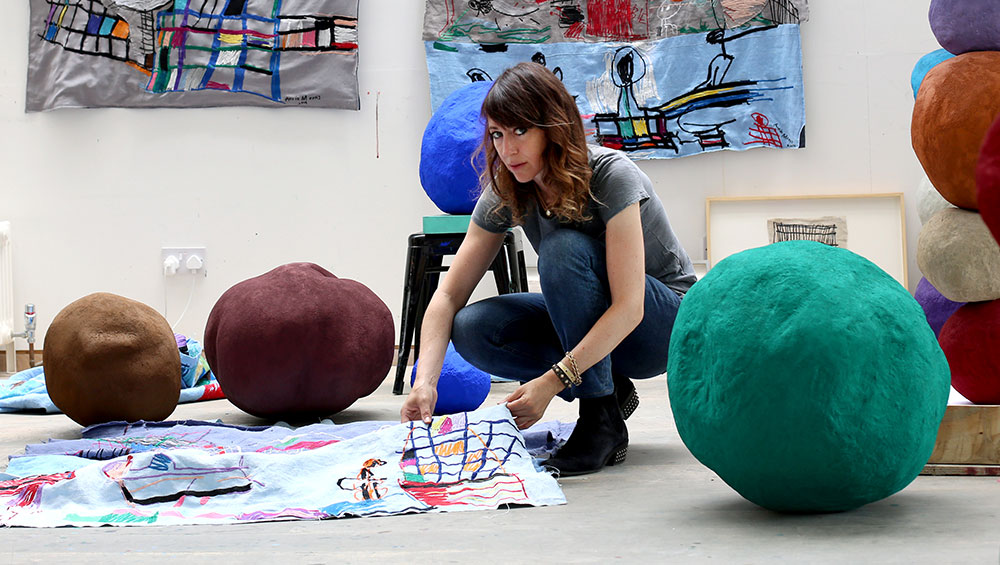
Annie Morris, 2021. Photo © Stephen White & Co.
by DAVID TRIGG
Annie Morris (b1978, London) takes great delight in process and materials. From the roughly hewn surfaces of her colourful sculptures to her scribbly oil-stick drawings and assiduously sewn tapestries, she is always pushing for more vibrancy and increased vitality. Informed by personal experience, memory and the subconscious, her works crowd the north London studio that she shares with her husband and fellow artist Idris Khan. Most prominent are her precarious-looking Stack sculptures. These signature works comprise irregular spheres placed one on top of the other. Varying in size, scale and colour, they appear like columns of delicately balanced boulders. Yet beneath their jubilant appearance lies a sombre undercurrent: the series began after Morris and Khan suffered the loss of their first child to stillbirth. For Morris, the Stacks are defiant, standing tall against the odds. Operating as metaphors for hope, each one suggests the possibility of surmounting the insurmountable in the face of life’s fragility.
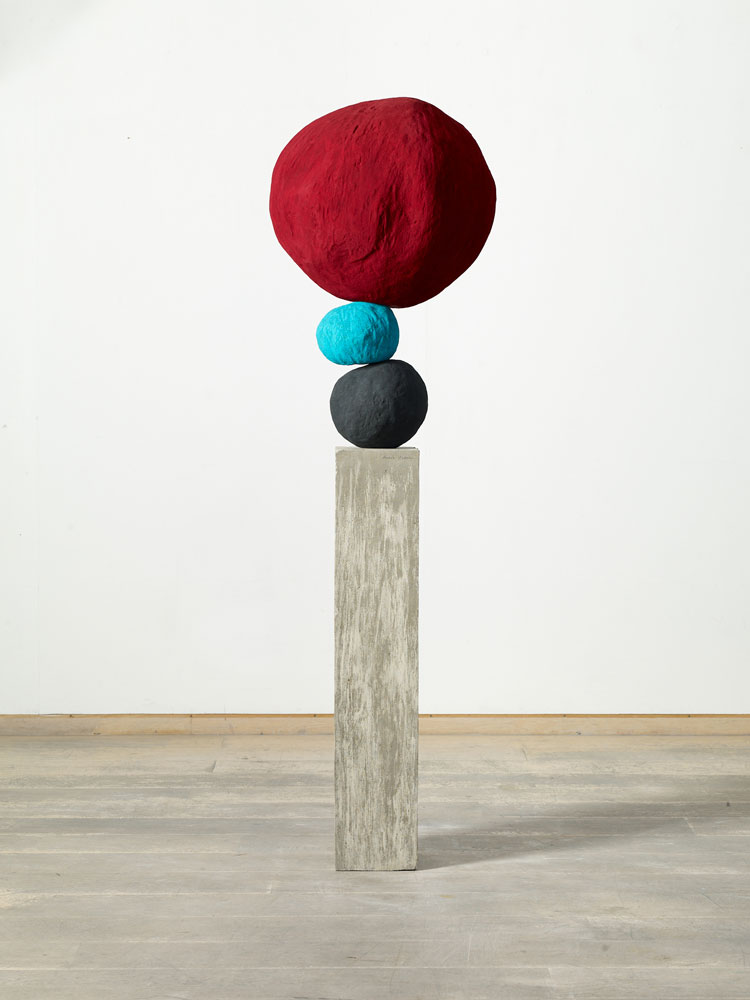
Annie Morris, Stack 3, Cadmium Red, 2020. Foam core, pigment, concrete, steel, sand and plaster. Photo © Stephen White & Co.
Drawing is similarly used by Morris as a site to explore past pains, though she is clear that autobiography is not the key to appreciating her strikingly assured works, whether in three or two dimensions. Working with a deeply personal language of motifs and forms, she draws freely and intuitively, rapidly laying down loose configurations of abstract marks and figurative elements. Incorporating the rich and earthy ultramarine, green, blue, burgundy and ochre hues of her sculptures, as well as their bulging shapes, she teases out relationships between these two very different modes of working.
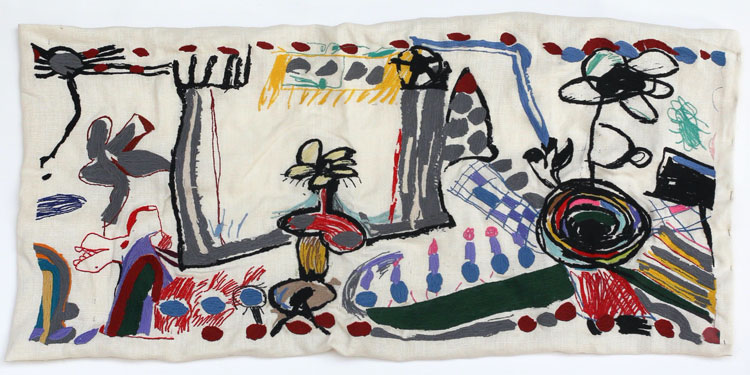
Annie Morris, Long Tapestry 2, 2020. Photo © Annie Morris Studio.
Recently, Morris has started translating her drawings into thread. She uses a sewing machine to emulate the drawn line on to unstretched linen, and her textiles slow down the drawing process, becoming something more akin to painting. But she has little time for definitions, she is more interested in inviting viewers to lose themselves in the landscapes of her imagination.
Studio International spoke with Morris as she was preparing for her first solo museum exhibition in the UK, When A Happy Thing Falls at Yorkshire Sculpture Park, her inclusion in Frieze Sculpture 2021, and a solo presentation of new work at Timothy Taylor, London.
David Trigg: Your most recognisable body of work is your Stack series, begun in 2014 and inspired by a personal tragedy. How important is it to you that the viewer knows the backstory of this continuing series?
Annie Morris: It’s not important, you don’t need to know it. In fact, it wasn’t known until I mentioned it in an interview once. Looking at the works, you’d never arrive at that conclusion – that I’d made them because of that tragedy and the grief I was going through. The feedback I often get when people talk to me about these works is that they feel very joyous, which to me is exciting.
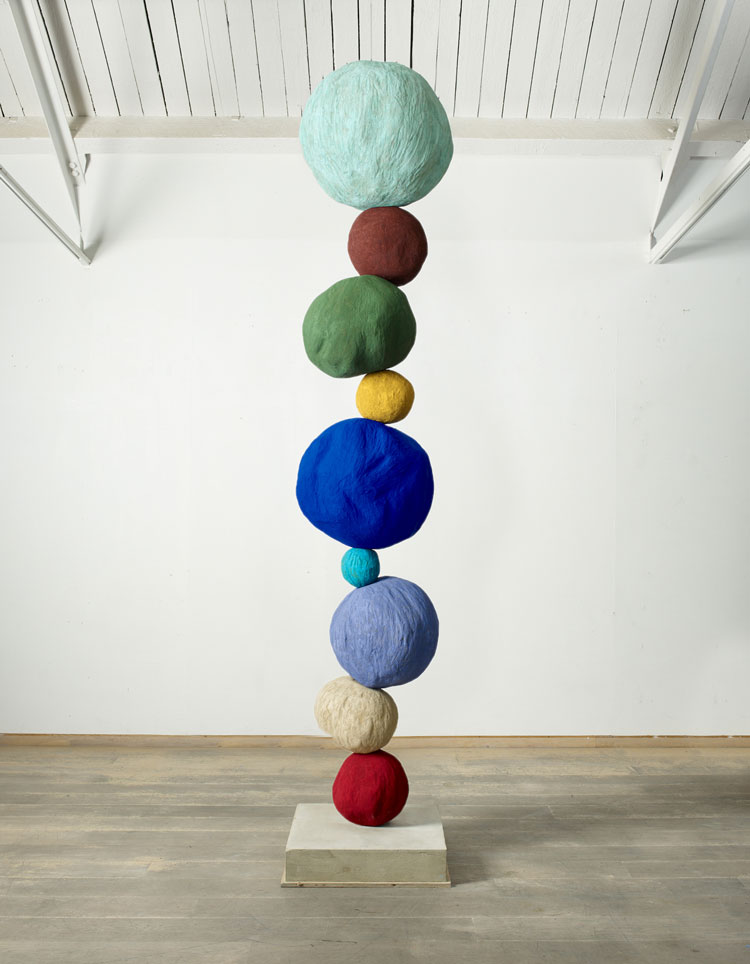
Annie Morris, Stack 9, Copper Blue, 2020. Foam core, pigment, concrete, steel, sand and plaster. Photo © Stephen White & Co.
DT: How, then, do you feel about the backstory becoming public knowledge?
AM: I’m fine with it because stillbirth is an important subject and I love the idea of using my tragedy to help other people. It is something that happens a lot: about one in every 200 births in England. At the time, I didn’t know anything about it, that it could happen to someone at that stage of pregnancy, at full term. I was naive. Everybody experiences tragedy at some point in their life and for me these Stack pieces are all about what happens afterwards. They have a hopeful quality to them I think, that’s what I want them to have.
DT: What prompted you to channel that personal tragedy into your sculptures?
AM: I didn’t do therapy or any of the things that you probably should do when you have a shock to your system like that. What really helped me was being able to lose myself in drawing. I spent time in the studio making these very obsessive ballpoint pen drawings; they were large and had these random balls in them, and faceless women – they were all about what I’d gone through with losing the baby. They were sad drawings because it was just such a dark time for me. Then I began introducing some little coloured lines, which were like the beginning of hope. For me, colour has always been something very hopeful and joyous, it’s what I turn to when I feel sad and, on a simple level, it just makes me feel happy. Those coloured lines were the starting point for the sculptures because I realised that they were what I wanted to focus on. I wanted to get away from the negativity. It then felt very natural to use the ball shape that I had been drawing because it was obviously the shape that had gone, the shape that I’d lost. I didn’t think I was going to get pregnant again and this shape was very comforting.
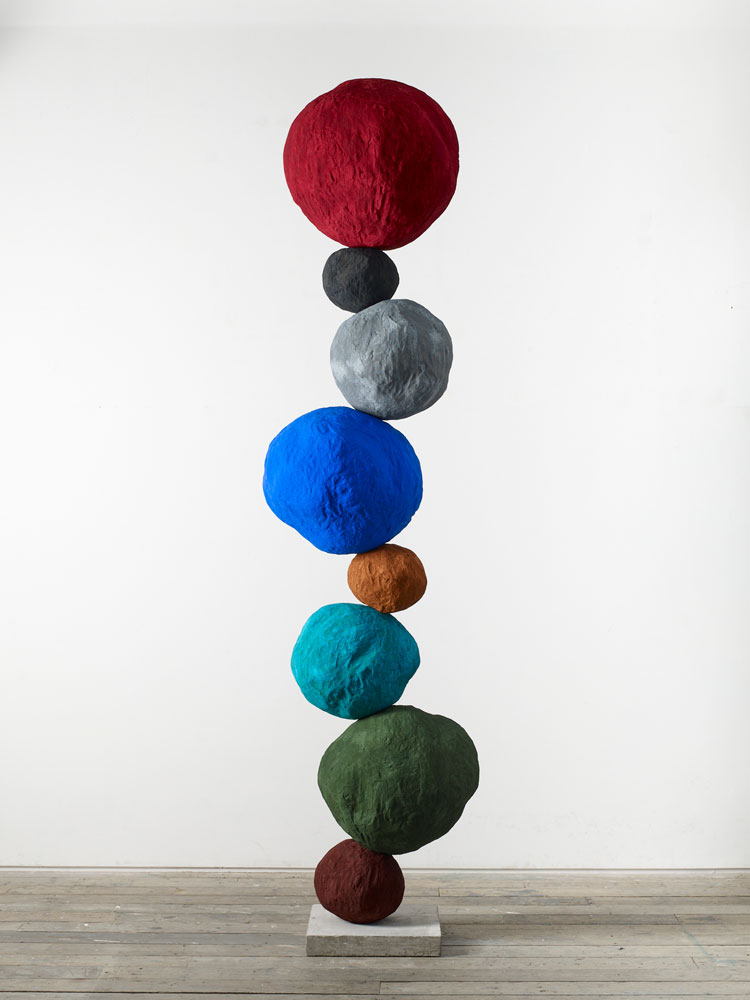
Annie Morris, Stack 8, Cadmium Red, 2021. Foam core, pigment, concrete, steel, sand and plaster. Photo © Stephen White & Co.
DT: Some people would want to run away from that reminder.
AM: That’s a good point, but for me it was – and still is – comforting to make this work because in a small way it keeps that thing alive, that thing that I wanted so much, which was taken away. As time went on, I became more interested in balance and in exaggerated shapes and forms. I love the way that in these sculptures the larger balls teeter on the smaller balls in defiance of gravity. I like that they seem impossible.
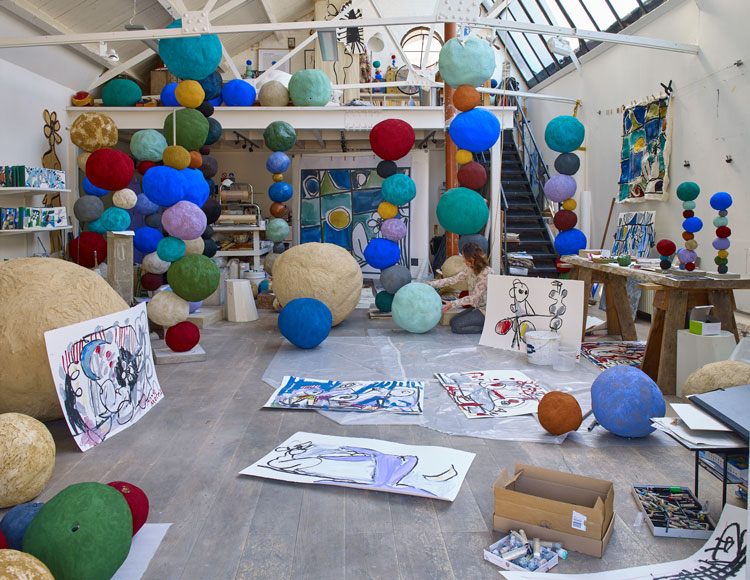
Annie Morris Studio, 2021. Photo © Stephen White & Co.
DT: What comes first, the colours or the arrangement of the balls?
AM: I work out the form first so that the balance is right. I tend to mock it up in watercolour. I make the balls in another studio, which is really messy. I carve them from hardened foam, a very simple material, which is then covered in layers of sand and plaster. I want the works to look raw and immediate, so the carving is quite crude, and they keep changing shape as I go. Then I’ll bring them to my painting studio where I apply the pigment. If it doesn’t feel right, I’ll replaster, re-sand and repaint, so there’s a lot of moving and changing of colour when I work on them. I have a lot of different elements on the go at once. I’ve investigated and trialled so many ways of doing it and I’ve got to know the way in which pigment reacts to different materials. For me it’s really all about the surface; I’m really fascinated with the surface and textures of paintings, and I want it to look as if the paint hasn’t dried on these sculptures. I love the vividness of raw pigment and I’m desperately trying to preserve that intensity. My earlier stacks aren’t as vibrant, but now I know how these pigments behave, so if I’m using an ultramarine blue, I know how to layer it so that it does what I want.

Annie Morris, Stack 9, Cobalt Turquoise, 2021. Foam core, pigment, concrete, steel, plaster, sand. Photo © Stephen White & Co.
DT: I have seen them described as totems, is that something you are happy with?
AM: I don’t mind how people describe them, but I don’t call them that. I call them Stacks, which is useful for naming and cataloguing but really, for me, they are just paintings, a sort of three-dimensional sculptural painting.
DT: You regularly use vivid ultramarine blue, viridian green and yellow ochre pigments in your sculptures. What informs your colour choices?
AM: My colour selection is intuitive but quite specific now because I’ve got to know these colours so well. I’m always searching for new colours though; I do a lot of oil-stick drawing so I often just play around with different colours. I’m using a new colour this year that I call Rome White, because I discovered it when I was doing a show in Rome; it’s a hazy, not-quite-white but not-quite-buff titanium that has a beautiful softness to it. I also get a lot of inspiration from just walking around: I may see a blue car passing a red one and love the combination, or find colours I like in other artist’s paintings. I’m mixing a lot of the colours in the studio now, which is a new development. Slight differences create real excitement for me. There’s a new light ultramarine that I’ve recently started using that’s really exciting, but it’s very difficult to use because it’s an extremely strong colour; as soon as you use it, there’s a need for balance because I don’t like it when one colour jumps out. I really love putting it with a purple pigment called caput mortuum.
DT: Have you explored different configurations of the balls other than stacking?
AM: No, I’m not interested because I find the stacks very comforting. I like the forms I’m working with and I’m not ready to move on to something else. Having said that, I have been thinking about maybe making some hanging sculptures. But I’ve been thinking more about scale. Next year, I’m making a giant 5.5 metre (18ft) bronze for a show at Château La Coste in Provence. Working on that scale is very exciting. I’ve also made a huge stack sculpture with three balls for my show at Timothy Taylor; it’s the largest one I’ve ever made, and I’ve got to complete it in the gallery because it’s too big to fit through the door. I’m also going to be pairing my new two and three ball sculptures as I like the conversations that happen between them. In that way, they’ve become slightly more figurative.
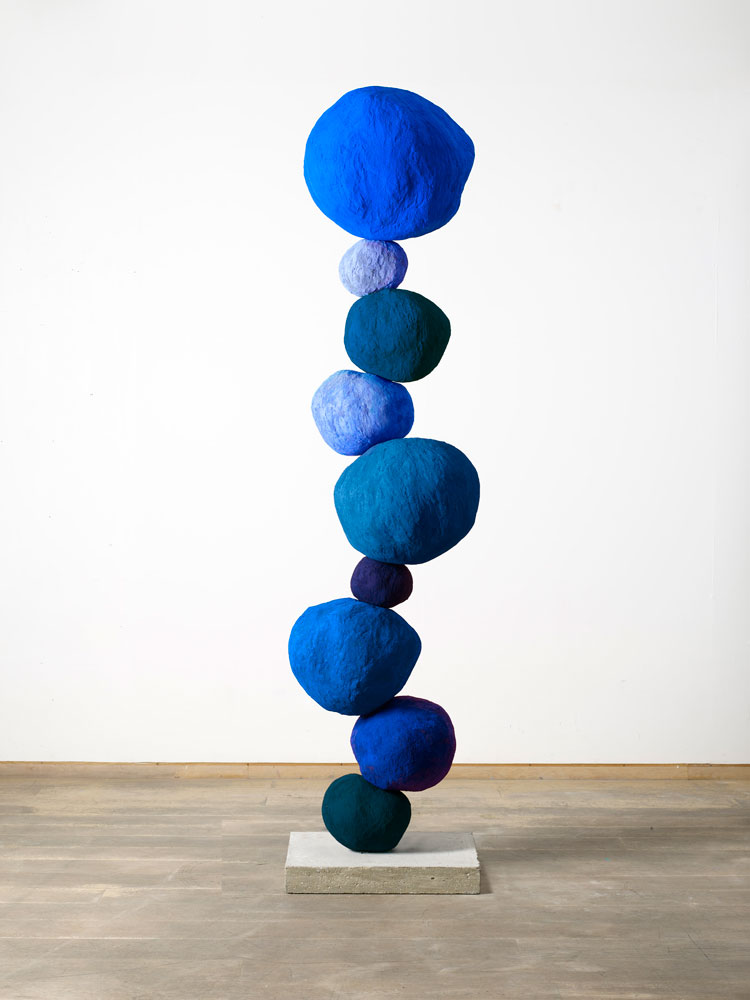
Annie Morris, Stack 9, Ultramarine Blue, 2021. Foam core, pigment, concrete, steel, plaster, sand. Photo © Stephen White & Co.
DT: You’ve also made a 3.5-metre-tall painted bronze stack for your exhibition at Yorkshire Sculpture Park (YSP).
AM: That was difficult because I’ve never made anything on that scale before. I initially carved it in my studio because I wanted a 1:1 model, to see the size. Everyone said I was insane because I could have just made a small maquette. I had originally intended to make the piece 5.5 metres tall but there were so many covid-related problems that it didn’t happen. Bronze is really exciting, and I worked with Pangolin Editions to create the sculpture at its amazing foundry. At YSP, I’m showing it on the lawn just outside the Weston Gallery. Inside, I’m showing a several large stacks. I want the show to feel like you’re walking into my studio – I keep a lot of work in my studio and there’s always a forest of sculptures, so I wanted to replicate the impact of seeing all those works together in one space.
DT: The parkland at YSP would be a great location to show a forest of bronzes, outside the gallery confines.
AM: I admire Barbara Hepworth’s The Family of Man at YSP. It’s such an interesting and beautiful work. If there was a way, one day, of creating something similar that comprises several elements coming together as one – a family or forest of bronze works – that would be fantastic. I have lots of ideas for public artworks.
DT: Tell me about the title of the exhibition, When a Happy Thing Falls.
AM: It comes from a poem by Rainer Maria Rilke, from his Duino Elegies. It was a title I originally used for a 2009 drawing. That line just moved me. It’s got an ambiguous quality that really resonated with me, and I think makes sense for this exhibition. It alludes to the reason for these works and also to this moment we’ve all been through. I like the idea of a happy thing being embodied as an object, and then thinking about how you respond when it falls and what happens next.
DT: You mentioned that Barbara Hepworth’s sculpture The Family of Man (1970) – on long-term display at YSP – is a source of admiration to you. Which artists have you learned the most from?
AM: That’s so tough to answer! There are certain artworks that I look at a lot, Henri Matisse’s The Piano Lesson (1916), for example, and also his Snail (1953). Artists that I go back to over the years include Willem de Kooning and Robert Rauschenberg – there’s a freedom to their works that I love and want for my work too. I would also have to say Louise Bourgeois, primarily because of the impact that her father’s infidelities had on her and her work – that really resonated with me because it is something that I also experienced. I remember reading about that as a young artist and feeling extremely moved. She became so inspirational to me because of that connection, and I had the wonderful experience of meeting her at her studio before she died.
DT: Apart from Bourgeois, all those artists are painters.
AM: I’ve always been interested in painters, perhaps even more so than sculptors. I’m also interested in people’s drawings, there’s something about the immediacy of someone’s hand on a page that really fascinates me.
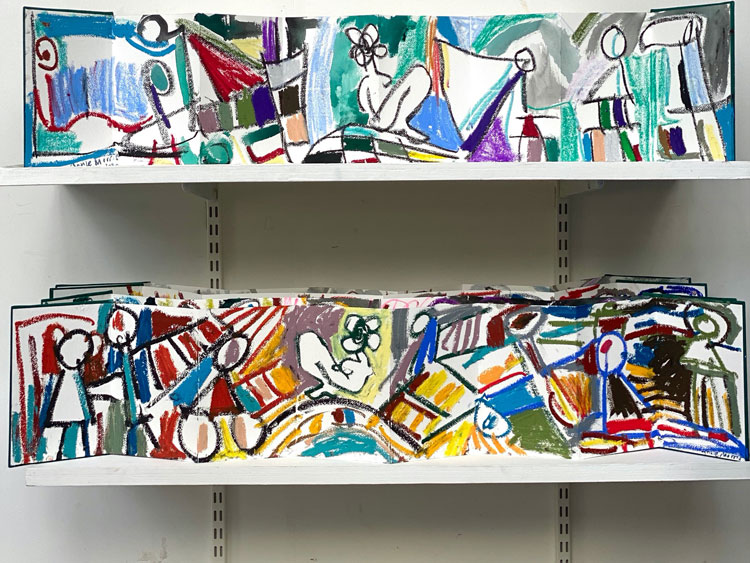
Annie Morris, Drawings on Shelves, 2020. Photo © Annie Morris Studio.
DT: Drawing is, of course, central to your practice. Your drawing language is very distinctive.
AM: Everything for me stems from drawing. As a child I used to draw incessantly. For me, drawing is very instinctive. I like placing huge pieces of paper on the floor, sometimes maybe five or six metres long; I move all the furniture from the studio, unroll a long piece, and just draw. I like to work really fast. I’m such an impatient person so I draw as quickly as I can to get from one end of the paper to the other. If I spend too long on a drawing, I get out of the zone of concentration, so I work better if I do something quickly. I use oil sticks, crayons and even highlighters so that I can vary the line, mixing thick lines with thin ones.
,-2019.jpg)
Annie Morris, Night Drawing (Invisible), 2019. Photo © Stephen White & Co.
DT: You mentioned that you did a lot of drawing as a child. The work you make now has something of a primal, childlike quality to it.
AM: Yes, you’re right, my drawings do have a childlike quality. I’m really attracted to children’s drawings. After the age of 12, a child’s drawings will start to become self-conscious but at around the ages of five or six they have an amazing freedom and I want my work to have that freedom too. Someone once said to me that a successful work is a work that a child might like.
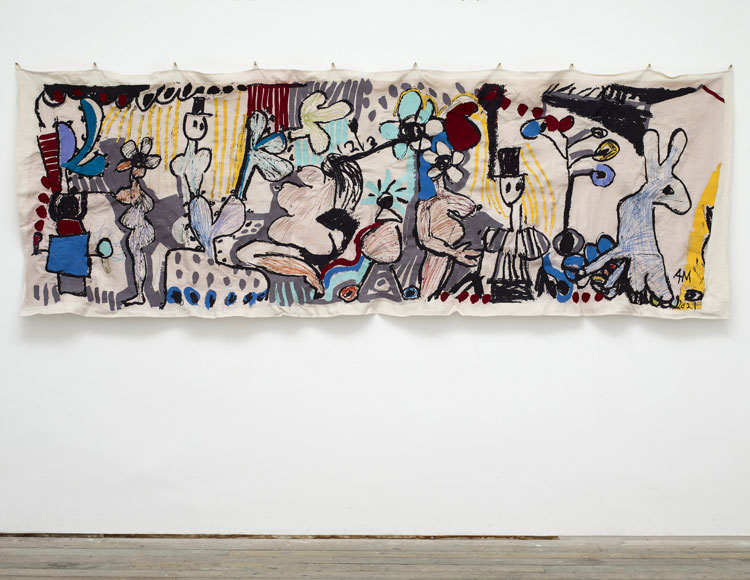
Annie Morris, Top Hat, 2021. Linen and thread. Photo: Stephen White & Co.
DT: You often return to the same motifs. What is their significance?
AM: I often just draw things as they come into my mind, but I do return to the same characters. I have this flower woman, a female figure whose face I’ve replaced with a flower. The character started as a kind of self-portrait. She’s very quick to do so I quite like using her. The flower is not a pretty flower though, it has nothing to do with beauty, it’s much darker than that. It came from something that happened in my childhood, which I remembered years later. I also draw a lot of trees and grids, and there are these figures with hats, which remind me of a very gentlemanly gentleman – he is based on a childhood memory of a very decent man.
DT: Is a lot your imagery inspired by childhood events and experiences?
AM: Yes. All my work revolves around the different experiences that I’ve had or situations I’ve been in, though without being literal or descriptive. A lot is based on things that I’m not comfortable talking about. My parents got divorced when I was a child. In fact, my father had a secret family, which was a super-shocking event that still triggers a lot of memories for me. I have a big catalogue of imagery in my head that comes from that experience. It’s all about relationships and pain, heartbreak, grief, death and also love, a lot about love. I’m becoming more comfortable with what happened, but I don’t really talk about it and I’m never going to be standing there with someone in the gallery, explaining it as they’re looking at my work. It’s much more important to me for people to have their own response to the work. For me, drawing helps to bring closure to things – I know why I had to make a particular drawing, but that has nothing to do with the reason why someone else might like it.
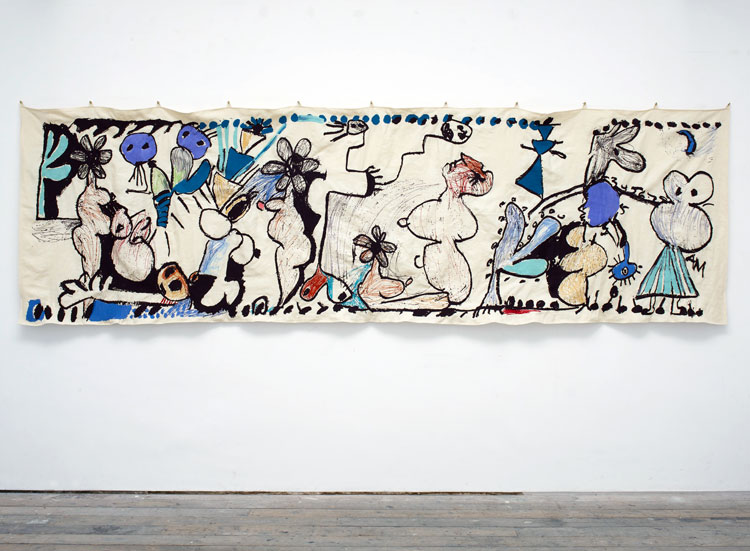
Annie Morris, Untitled, 2021. Tapestry, linen and thread. Photo: Stephen White & Co.
DT: How has the pandemic affected your practice?
AM: So many things fell through for me. The YSP show was pushed back and my first exhibition in Tokyo was cancelled, along with a number of international group shows. I travel so much for work and all that stopped. I moved to the countryside with my family and, because I couldn’t make my sculptures, I did a huge amount of drawing. I was with my children all day, so I stayed up really late making drawings, which I loved. I’m quite a late-night person anyway, so I liked working at 2am because I didn’t have to get up to take the children to school the next morning. It was a good time to make different work and change things up.
DT: How did your work change during that time?
AM: During the pandemic, I was making oil-stick drawings and then sewing over them, trying to make the sewn line look like pen or oil stick. I’ve been working with sewing for a while, making these quite scribbly three-coloured tapestries, but I wanted to push the sewing I was doing in a different direction. Scribbling in the sewn mark is quite beautiful and I wanted to take that and introduce the thickness and richness of oil stick. For the new ones that I’m showing at YSP and at Timothy Taylor, I screen printed my drawings on to the fabric and then sewed over the top, changing the colours here and there. I love getting into the groove with the sewing machine, I like the energy of the process. It’s extremely laborious and time-consuming, but I really want them to look quick and spontaneous. I’m calling them thread paintings because they are somewhere between drawing, sewing and painting.
DT: The fabric, which is unstretched, almost looks like crumpled paper.
AM: Exactly. It has a nice unfinished quality. Sometimes things can get too slick, which is why I like things to be very raw, as if they’re not quite finished.
DT: What else have you been working on?
AM: I’ve just completed a commission for Claridge’s – it’s a bar called the Painter’s Room and is the first time in 100 years that the hotel has opened a new bar. I’ve been working with [the hotelier and owner of Claridge’s and Château La Coste] Paddy McKillen on the Château La Coste show, and he invited me to do this commission. It’s a very small space, only seating about 30 people, and I’ve decorated the walls with monochrome murals based on my drawings. I wanted to draw directly on to the walls but because it was Claridge’s, and I liked the idea of things being more refined, I created this new process where I drew the images, manipulated them on a computer and had them made into vinyl transfers. Then I painted the vinyl with three or four layers of paint so that they have a slightly raised, embossed look. I also took one of my tapestries, which began as a watercolour, and made it into a stained-glass window for the bar. It was really exciting to work with glass and I tried to make it appear like a watercolour painting. The colours look incredible in these beautiful hand-blown pieces of glass.
DT: Is that something you would like to explore further?
AM: Yes, I’d love to make a show of stained-glass works. It’s a really exciting new direction and I think it could be the next thing for me.
Annie Morris: When A Happy Thing Falls is at Yorkshire Sculpture Park from 25 September 2021 to 6 February 2022. Morris’s solo exhibition at Timothy Taylor, London, runs from 6 October to 13 November 2021. Frieze Sculpture 2021 is on now in Regent’s Park, London, until 31 October 2021.